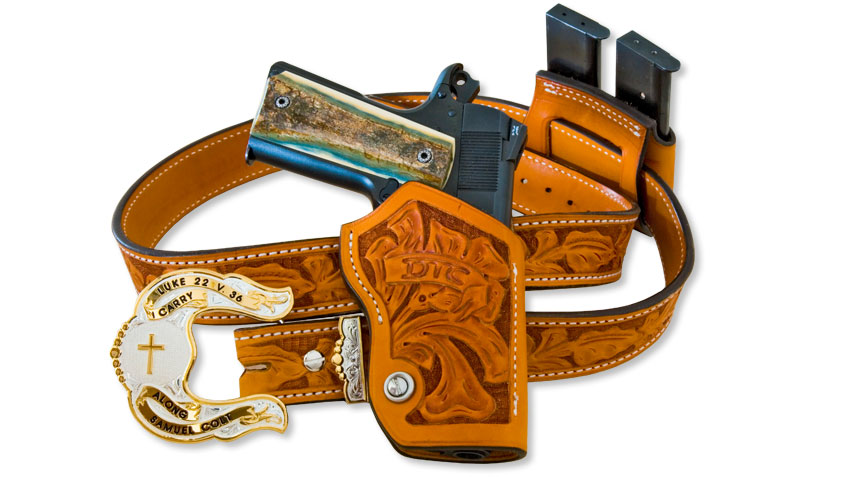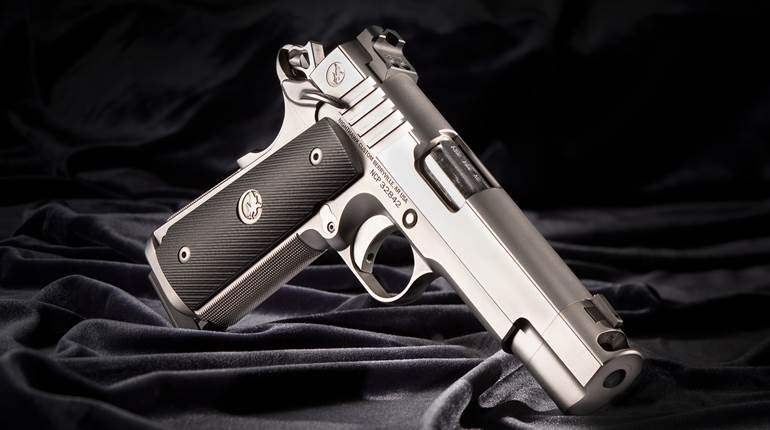
Suppose you found yourself in the position of building your ultimate everyday carry pistol. It’s sort of like building the ultimate pickup truck (for rednecks like me) or the ultimate sport coupe (for the city fellers). You start with a blank sheet of paper and … .
The first question is revolver or semi-automatic. For most of my life, I have had a revolver close at hand. My rather modest collection includes Smiths, Colts and Rugers, and I love them all. If I did get into a fight and was armed with any of my center-fire revolvers, I would not snivel about being under-armed. However, there is another side of me—the 1911 guy. I started shooting a 1911 about the same time I started shooting handguns seriously. My first 1911—a Colt Series 70 Government Model—is still with me, though it got a nice face lift about 20 years ago after I’d put about 50,000 rounds through it. It has been close to me for quite a long time, and it never has stuttered a bit. There are a few other 1911s lying around here as well.
When I was younger, I thought nothing of strapping 3 or 4 lbs. of iron on my hip and going about my business for the day. The thought of whining about too much weight never entered my mind. Only a wuss would complain. Well, as one gets a few years on themself, one’s body undergoes some changes, and, as such, one’s perspective gets altered, meriting some reevaluation of old ideas. One of those reevaluations is that I don’t care to strap on a full-size, all-steel handgun every day. It’s OK, once in a while, or, say, for the occasional days of goofing off in the backcountry. But day in and day out, since I don’t regularly need to use a handgun, I appreciate something a little less massive.
The author's Colt Commander "before" picture.
About three years ago, I was surfing Gunbroker.com and came upon a 1970s-vintage Colt Commander. The pics didn’t show any unusual wear, and about the only thing not original on the gun were its stocks. Too, it did not have an astronomical reserve, so I bid a reasonable price on it and won. Upon inspection when I received it, my evaluation of the pistol proved true, perhaps even better since it did not appear to have been shot a lot. I put about 300 rounds of hollowpoints through it without a stutter and began carrying it more or less regularly. It seemed accurate enough, even with the factory trigger—something I normally can’t stand. And at about half the weight of my full-size 1911s, it was a joy to carry.
Nonetheless, I am a 1911 geek, and as such I always believe I can make it better. One perennial ding I have with the 1911 A1 is that damnable grip safety. Under the best of circumstances it is a nuisance. My hands are thick and fleshy; my digits are short—a primary reason I must relegate myself to single-stack semi-autos—so my grip must be perfect in order to run the gun. In a fight, I’d be up that proverbial creek if for some reason I did not acquire a perfect grip on my pistol. In the past, I taped the grip safety down—many others have drilled a hole in the frame and pinned the grip safety in the off or fire position. Still later, accessory manufacturers made grip safeties with a cheater pad at the bottom to ensure its disengagement at the proper time. But my disdain for this unnecessary redundant remained high. If you know how to run the gun—I’ve been at it for 46 years with no negligent discharges whatsoever—why have it?
The grip safety was an afterthought by the then-War Department when it was specking out the pistol during its transition from a mounted horse cavalry to a mechanized cavalry. Some grizzled old coots—I can say that because I am one too now—that ran the department were afraid of somebody getting hurt with a cocked pistol in one hand and horse reins in the other. In the 106 years since this pistol was adopted, many of us have learned how to manipulate this gun safely without relying on mechanical disablements.
Wayne Novak—the guy who has pretty much revolutionized modern pistol sights—came up with a simple and logical solution to this grip safety nonsense a few years ago. Eliminate it altogether, and replace it with a one-piece backstrap/mainspring housing. Subtly dubbed “The Answer,” Novak has been quietly offering it to those who know how to run the 1911. You cannot simply buy "The Answer" and install it yourself. It must be fitted and installed by one of Novak’s superb pistolsmiths.
So I sent my Commander to Novak’s president, Charley Pulit, for evaluation and installation of "The Answer." I asked for a couple of other mods—a lowered and extended manual safety, a trigger job and, of course, a set of sights. Charley called me a few days later and dove into an esoteric diatribe regarding the slide stop on my Commander. He told me some things about the manufacture of 1911s during the late ’70s—mine was made in 1979—and tolerances were relaxed and on and on. My eyes started to glaze over as I was beginning to feel depressed at the prospect of this project not being completed. Suddenly Charley said, “We’ve decided that your pistol deserves a complete build from the ground up.” He had been sandbagging me.
Charley turned my Commander over to Matt Whitlatch. Matt quickly fitted the pistol with "The Answer," along with a Novak hammer, Novak’s Gunfighter manual safety which is lower, wider and more rounded than most aftermarket 1911 safeties. That safety, by the way, is very positive when engaging or disengaging, making the lack of a grip safety a true moot point. He replaced the trigger with a short one at my insistence and installed a trigger stop. The slide was ported and fitted with Novak’s LoMount sight with tritium inserts. Along with everything else that is failing as I age, my once 20/10 vision has decayed, and I need all the help I can get. Matt hand beveled the magazine well, then trued up some lines and curves on the frame in the interest of aesthetics. A new Kart match-grade barrel and bushing were added, and he crowned the barrel. The pistol was given a “carry bevel treatment,” meaning that edges were softened—notably not given the melted or well-worn look, and a set of slimline grip bushings were installed. Then the steel parts were sent out for hot-salt black nitride finishing and the frame was sent out for re-anodizing and a Black-T finish. There is no white metal visible on the gun. Matt then went down and shot a 25-yard group measuring 1 1/2".

All of my life I have had a weakness for pretty things—furniture, trucks, boots, artwork, guns—the list is way too long. Most have been bad investments of my time, money and blood. The paltry few pretty guns I have acquired, however, have been very good to me. They all shoot well, and they satisfy my penchant for pleasing aesthetics. The reason I tell you this is to explain why I did the following to a pistol that’s sole purpose is to save my posterior.
When I carried the Commander, I used a 35-year-old Milt Sparks Yaqui Slide and mag carrier. It’s functional, lightweight and easy to conceal. Then, Mike “Doc” Barranti posted a pic of a renaissance rig he made in honor of Milt Sparks. Christened the MST (Milt Sparks Tribute), it is a replica of one of Milt’s first holsters he made for 1911s. But Doc being Doc, applied carving to the belt, holster and mag pouch. He didn’t have to set the hook; I swallowed it whole and immediately ordered up one for my Commander. Usually, Doc does an oak leaf carving. He asked me what I wanted, and I told him to surprise me. He did. Mine has floral carving and a ribbon with my initials across the face of the holster. I supplied a buckle from Montana Silversmiths. Most leather holsters require a little break-in period. Not this one. From the first time I put it on it fits perfectly, retaining the pistol securely, yet releasing it quickly during the draw.
If the leather isn’t over-the-top enough for you, how’s this? I replaced the old aftermarket walnut stocks—which were OK—with slimline mammoth ivory stocks from the Boone Trading Co. I was immediately chided by friends who pointed out accurately that 10,000-year-old ivory is mighty fragile, especially for an everyday carry gun. True, but I no longer frequent saloons where I might be chivvied into a bar-room brawl, nor do I carry this gun when I am doing dirty, rough chores outside.
Will fancy leather and ivory stocks make the gun or me perform better? Absolutely not. Can I justify this opulent expense? Only in that it delights me to have something so pleasing to my eye that shoots.
So how does this rig perform? Well, I confess that I can no longer shoot a 1 1/2" group at 25 yards on demand. A 2 1/4" is about the best I can do today. Still, this Commander shoots right along with my two other custom, full-size 1911s.
I would never try to put forth the notion that this all-out, luxurious Commander is the perfect everyday carry gun for anybody besides me. It’s quite possible to have a near duplicate from other manufacturers at a much lower price point. As I said before, I am an unabashed 1911 geek, and, as such, I know what I want. My choices may not—are probably not—your picks. But when you have a few moments, you may want to do a little dreaming. After all, some dreams come true.






































